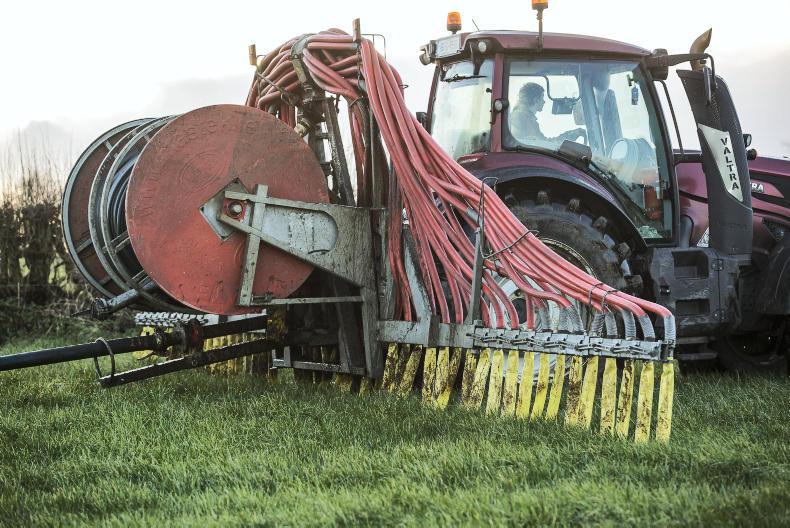Farmers and contractors buying dribble bars and trailing shoe slurry spreaders face a wait of up to six months.
Machinery manufacturers are reporting strong demand for low-emission slurry spreading equipment, which the Environmental Protection Agency (EPA) has urged farmers to use to reduce ammonia emissions.
Hi-Spec currently has a 16-week wait for a single axle tanker or a 20-week wait for a tandem axle.
“Demand on the trailing shoe and dribble bar is the main driver, but then there is also the derogation rules,” said sales coordinator Jim Nolan.
“People can see that regulations will tighten up.”
Major Equipment is reporting 16 to 20 weeks’ wait for systems over 2,000 gallons, with demand split evenly between dribble bars or trailing shoes. “Nearly all are TAMS applicants at the 40% rate,” said sales manager Martin Walsh. Hi-Spec, too, said TAMS grants were driving demand.
Mastek has sold 220 dribble bars this year to date, almost as many as it sold last year in total.
Delay
“We manufacture 10 a week and we sell 12 a week,” managing director Paul Quinn said, adding that this is causing a six- to 12-week delay.
EPA experts this week warned of an “immediate requirement” for more widespread use of low-emissions spreading, along with protected urea fertilisers, to reduce ammonia pollution.
The toxic gas is released when some of the nitrogen in slurry or fertiliser volatises after spreading, and Irish emissions increased above EU limits in 2017 for the second year in a row.
“A 26% increase in dairy cow numbers and 24% increase in nitrogen fertiliser use over the period 2012 to 2017 are the most significant drivers,” the EPA reported.
Over 99% of ammonia in Ireland comes from agriculture and emissions must decrease by 2020 and again by 2030 under EU law.
Read more
Livestock and fertiliser push ammonia emissions over limit
Tough slurry rules could cost farmers €35m
Protected urea: your questions answered
Farmers and contractors buying dribble bars and trailing shoe slurry spreaders face a wait of up to six months.
Machinery manufacturers are reporting strong demand for low-emission slurry spreading equipment, which the Environmental Protection Agency (EPA) has urged farmers to use to reduce ammonia emissions.
Hi-Spec currently has a 16-week wait for a single axle tanker or a 20-week wait for a tandem axle.
“Demand on the trailing shoe and dribble bar is the main driver, but then there is also the derogation rules,” said sales coordinator Jim Nolan.
“People can see that regulations will tighten up.”
Major Equipment is reporting 16 to 20 weeks’ wait for systems over 2,000 gallons, with demand split evenly between dribble bars or trailing shoes. “Nearly all are TAMS applicants at the 40% rate,” said sales manager Martin Walsh. Hi-Spec, too, said TAMS grants were driving demand.
Mastek has sold 220 dribble bars this year to date, almost as many as it sold last year in total.
Delay
“We manufacture 10 a week and we sell 12 a week,” managing director Paul Quinn said, adding that this is causing a six- to 12-week delay.
EPA experts this week warned of an “immediate requirement” for more widespread use of low-emissions spreading, along with protected urea fertilisers, to reduce ammonia pollution.
The toxic gas is released when some of the nitrogen in slurry or fertiliser volatises after spreading, and Irish emissions increased above EU limits in 2017 for the second year in a row.
“A 26% increase in dairy cow numbers and 24% increase in nitrogen fertiliser use over the period 2012 to 2017 are the most significant drivers,” the EPA reported.
Over 99% of ammonia in Ireland comes from agriculture and emissions must decrease by 2020 and again by 2030 under EU law.
Read more
Livestock and fertiliser push ammonia emissions over limit
Tough slurry rules could cost farmers €35m
Protected urea: your questions answered






 This is a subscriber-only article
This is a subscriber-only article










SHARING OPTIONS: